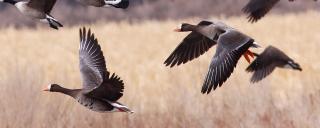Greater White-fronted Goose
 |
| Fact Sheet |
| Scientific Name |
Anser albifrons |
| Wing spread |
60 inches |
| Body length |
29 inches |
| Weight |
6.3 pounds |
| Description |
Both sexes have pinkish bills, white face patches, and grayish-brown heads, necks and bodies. Breast is marked with black blotches and bars, and legs are orange. |
| Nesting Habitat |
Nest on the ground in upland areas and tidal flats of arctic rivers, and coastal plains of Canada and Alaska. |
| Clutch size |
5 eggs |
| Incubation period |
23 days |
| Status in North Dakota |
The white-fronted goose is fairly common during migration seasons, but does not nest in North Dakota. |
| Food habits |
Grazes primarily on foliage grasses, seeds and tubers on tundra breeding grounds. Feed heavily on agricultural crops during migration and on wintering grounds. |
| Fun Facts |
Dark blotches and irregular bars on the breast have led to the common name of specklebelly or tiger breast. They are a trophy bird for North Dakota goose hunters. |


